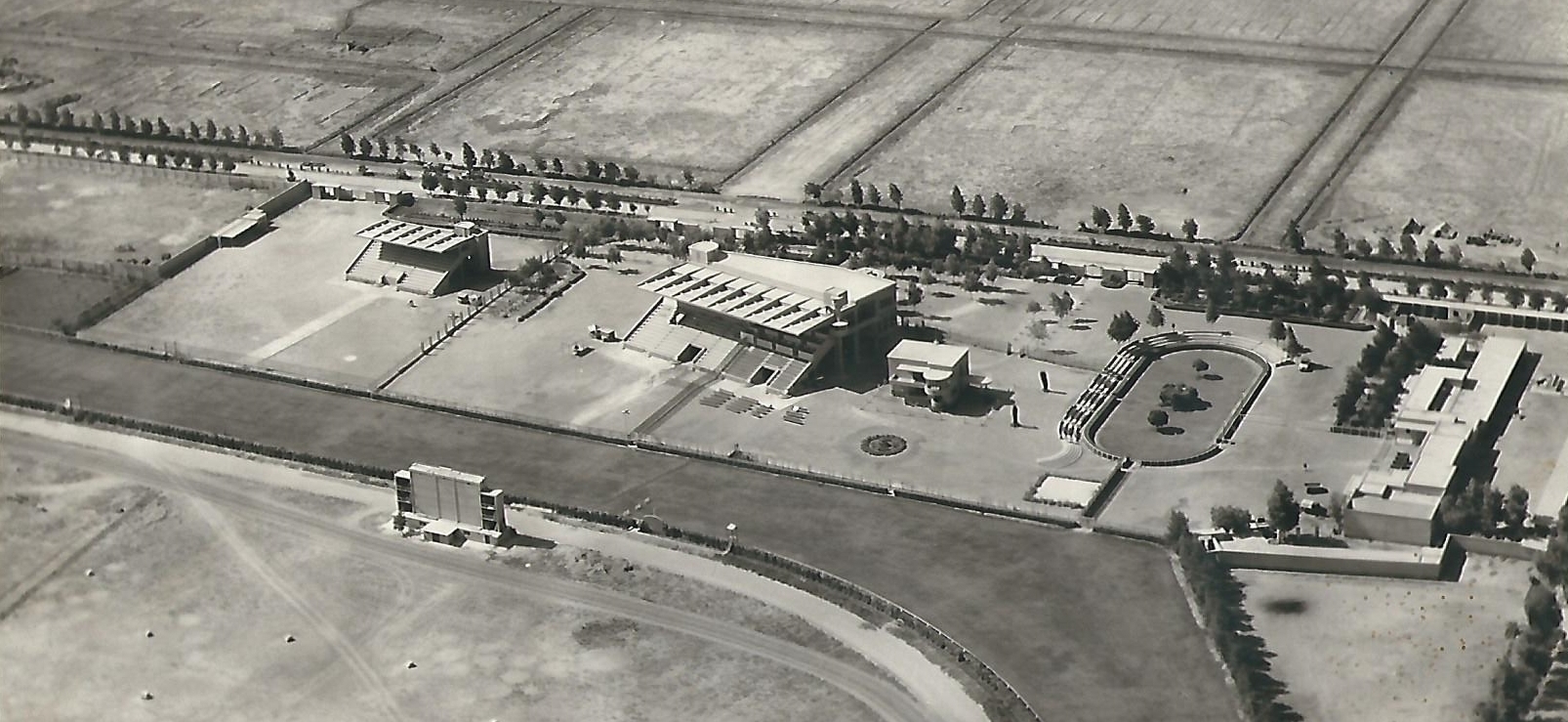The Beginnings
By Hussain Al Rikabi, Civil Engineer
April 2021
“The Beginnings, Al Mansour City” is a personal recollection of the city, its beginnings, its development, its people and community, the horse-racing track, Al Mansour Club, its streets, schools and houses, while living in the city for 20 years from the mid-fifties to mid-seventies.
I would like to share some of my recollections about AL MANSOUR CITY; beginning before my kindergarten years, when I occasionally accompanied my father Ali Haidar Al Rikabi to his workplace. This was located in the middle of AL MANSOUR City along the horse-racing track, and next to the spectators’ stands. In those days he was the managing director of the Al Mansour Company developing the suburb. The Company also owned the horse-racing enterprise. I used to run around the spacious grounds with my late brother, albeit under senior supervision and not on horse-racing days.
My family resided in AL MANSOUR City for twenty years, from the mid-fifties to the mid-seventies. While my father was working in the Company, we lived in the Director’s house right next to the racing track fence. From our garden we watched the horses running on racing days. After my father left the Company, we went to live in a residential unit annexed to Al-Mansour Club; later moving to a rented apartment in the Company’s residential building. After getting evicted from the building, we rented a house also in AL MANSOUR.
For many years Iraqis considered ‘AL MANSOUR City’ a prestigious address for a house in Baghdad. Yet, this now bustling area is by far larger than the new, serene suburb it was in the 1950s. AL MANSOUR was the last inhabited suburb to the west of Baghdad. Residents had an unobstructed view of the booster radio transmission towers located near Abu Ghreib village much further west on the road to Fallujah.

Newspaper promotion for Al Mansour City and racing events
The area in between, which used to be farmland planted with clover, has been completely urbanised extending even beyond Abu Ghreib. AL MANSOUR nowadays can be considered an inner suburb of Baghdad. It is still prestigious, but less so than Jadiriya, bounded by River Tigris on three sides.
‘AL MANSOUR City’ was established around 1946 as a real estate development enterprise by Al-Mansour Company, owned by wealthy families including the Fattah Pashas, the Chalabis, the Shabendars, a Scottish contractor (*) and an English general (**). The Royal Family too owned shares in the Company.
The hub of AL MANSOUR City was the elliptic horse-racing track. It was situated in the middle of a vast rectangular area at the centre of the City, oriented north to south and bounded by four main streets. From them smaller streets branched out crossing circular streets approximately parallel to the racing track. AL MANSOUR City master plan was designed by Mr Katarinchek, a Yugoslav architect based in Alexandria, Egypt. Al-Mansour Company commissioned him to also design the racing track and relevant structures, as well as a six-storey residential building. He was already well known for his design of the Smouha horse-racing facilities and other buildings in Alexandria, Egypt.
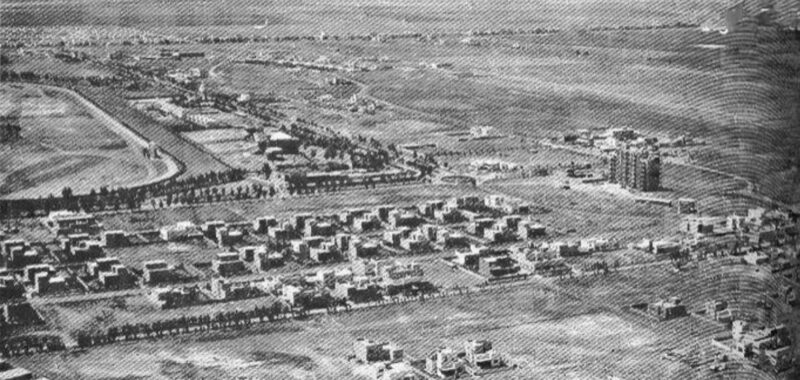
Al Mansour City aerial view. Clockwise from top left: Race-track, Al Mansour Co. grounds, Al Mansour Co. residential building, Rafidain Bank houses. Image courtesy Hunting Aeroservices, London, (Hussain Al Rikabi collection)
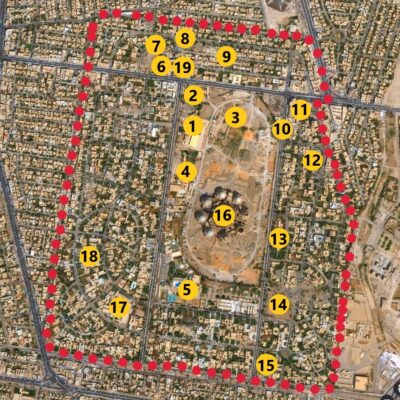
Al Mansour city location map
Location map index: 1) Spectators stands, Royal Loge. 2) Al Mansour Co. headquarter, 3) Horse-racing track, 4) Al Mansour Club, 5) Hunting Club – built 1970s, 6) Al Mansour Co. residential building, 7) Catholic Church, 8) Al Mansour co. employee houses, 9) Rafidain Bank houses, 10) Amirat Street, 11) Residential Building by Iraq Consult 12) Dijla School, 13) Amirat houses, 14) Public park, 15) Architect Ja’far Allawi House. 16) Mosque – construction started 1990s, 17) American School / Baghdad High School, 18) Block of 20 houses by Qahtan Madfai, 19) Rafidain Bank by Iraq Consult. Note locations are approximate.
The huge rectangular area comprised two spectators’ stands, Royal Loge building, racing track, inner ring for horse training surrounding a golf course, Al-Mansour Club, Al-Mansour Company headquarters and annexes, a small orchard, a horticultural nursery and the Company Director’s house. Four paved streets surrounded the hub, with myrtle hedges and palm trees planted in the medians and oleander shrubs on the sides, irrigated by ditches fed by water pumped from Al- Khirr rivulet to the east of the City. The water ditches also irrigated the horticultural nursery and an orchard planted with strawberries (chilek) and other fruit trees located south of the Club. In the 1970s a big Hunting Club was built on the remaining area to the south. In the 1990s construction of a colossal mosque was started on the golf course in the middle of the hub but it remains unfinished since construction was halted in 2003.
Owned by Al-Mansour Company, the horse-racing enterprise was successful from the beginning. On days when the races were held people from all over Baghdad came to bet on the horses. Some came to spend a pleasant day just watching the horse-races – and perhaps exploring the streets of AL MANSOUR City. However, the land plots were not selling as planned. Baghdadis were reluctant to leave their familiar environment to venture residing “in the middle of nowhere” as AL MANSOUR City was described in the early years.
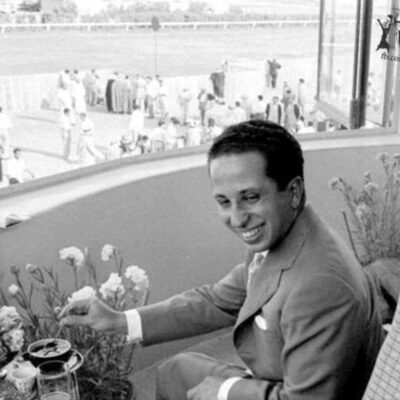
King Faisal II in the Royal Loge.
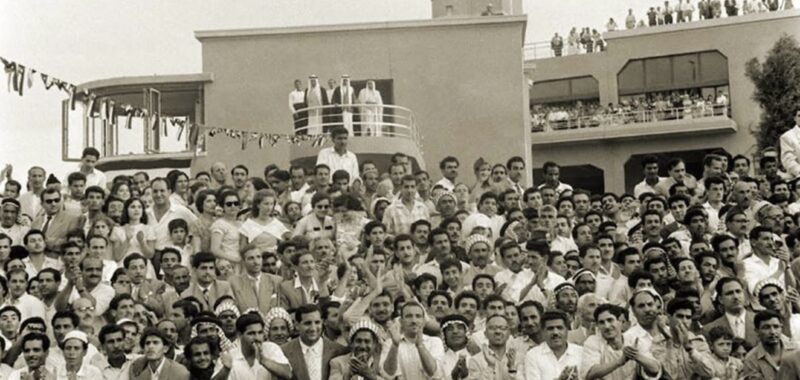
Annual Royal Cup Race; Kings guests on Royal Loge Balcony, spectators on grandstand balcony and roof, spectators on the side of the pre-race round where the King presents the cup to the winner.
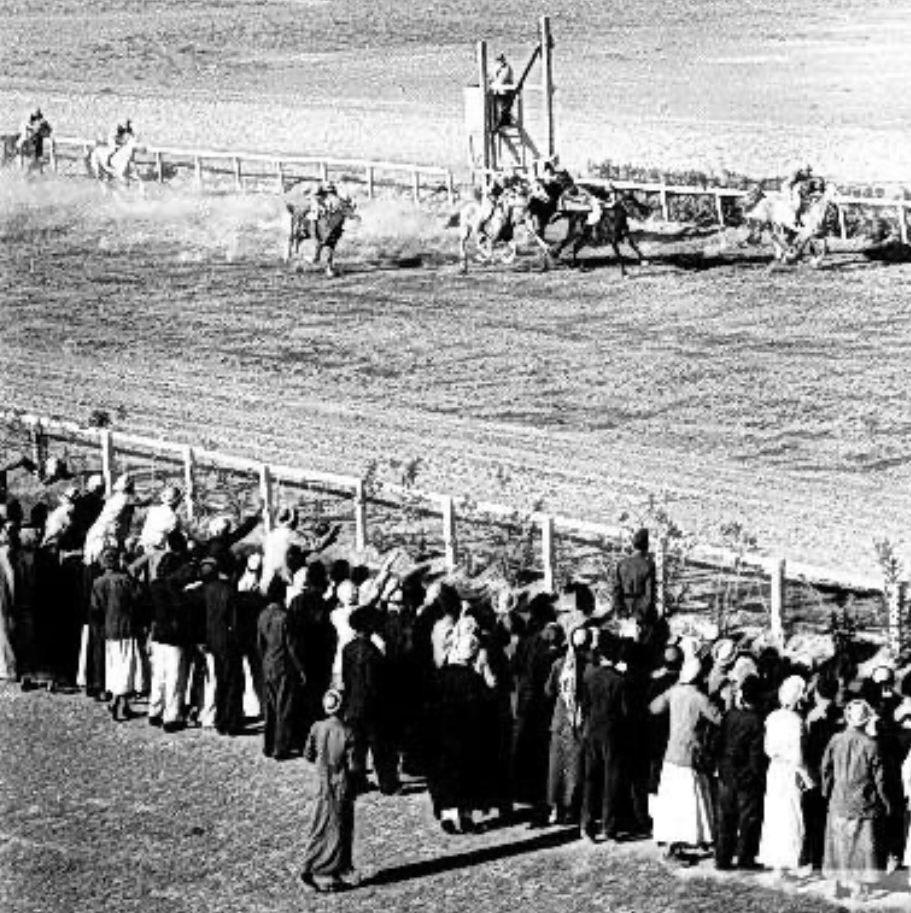
Racing Horses on the track, official steward on observation platform, spectators at fence.
In order to encourage people to buy land the Company built twenty houses and sold them at cost. With each plot measuring 1500 square meters, they were located on a block between two parallel streets adjacent to the American School for Girls. Designed by Qahtan Al Madfai, ten were one-storey houses and behind them ten two-storey houses. Most of the houses were sold and inhabited within 2-3 years. By that time construction of the American School was completed. It used to have an elementary school as well, which was closed down after the 1958 revolution. After that the Ministry of Education built Dijla Primary ‘Model School’ near Amirat Street..
Rafidain Bank built houses on plots purchased along the street adjacent to the Church and sold them to medium-income government employees. On the next street Al-Mansour Company built houses and sold them to Company employees on easy instalment terms. An American company was contracted to construct them according to their custom design accommodating local climate, using new building materials and precast units.
Gradually, more plots were sold and new houses emerged. The increasing number of residents included Iraqi notables, government officials, ministers, businessmen, academics, the Mayor of Baghdad, the Chief of the Royal Court, an ex-prime minister, and others from all walks of life.
Princesses Badi’a and Jalilah, the aunts of King Faisal II, owned two prominent houses on the street east of the race track fence. This street came to be known in common usage as ‘Amirat Street’ after the July 1958 revolution ended the monarchy. The houses of Faruk and Mwaffak Fattah were located on Amirat Street as well as a small public park. On the street south of the race track Suleiman Fattah built his house and another for his daughter. They were later purchased by the Bunniya family, who built a couple more houses on the same spacious plot.
A number of houses were designed by prominent architects like Jafar Allawi, Qahtan Awni, Rifat Al Chadirji, Maath Al Alousi, Jibrael Khammou, Mohamed Makiya, Hisham Munir, Qahtan Al Madfai and others, thus adding to AL MANSOUR City a variety of architectural features not found in other neighbourhoods in Baghdad.
The American High School for Girls (later re-named ‘Baghdad High School in Al- Mansour’) was designed by American architect Ellen Jawdat. Married to Iraqi architect Nizar Jawdat, she was the first female practicing architect in Iraq. The school design was a showcase of a then-modish style, coupled with a very efficient functionality which, until now, remains unmatched by other school buildings in Iraq.
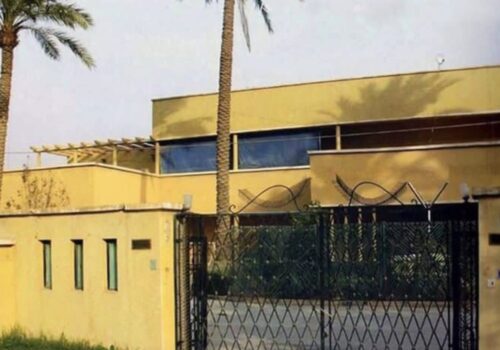
Amira Badia's House, built in 1950s.
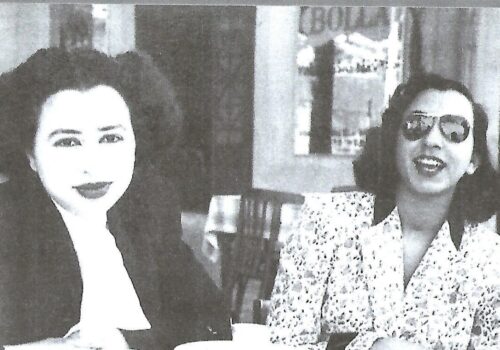
The Amirat Badi'a and Jalilah. Image source Memoirs of Princess Badi'a.
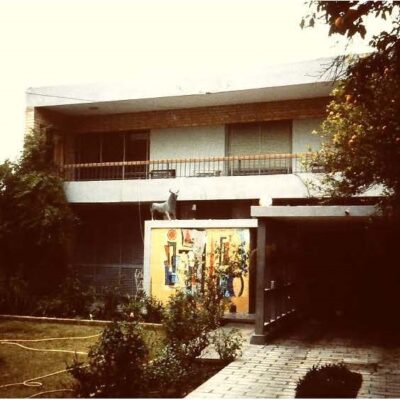
Architect Jafar Allawi House 1963. Image courtesy Jihan Allawi.

House by Architect Qahtan Al Madfai, built 1974.
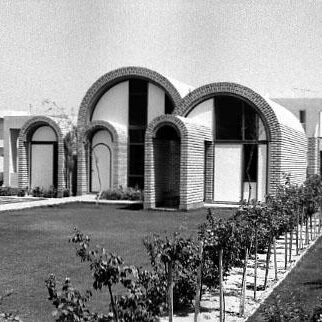
Hudaib Haj Hamoud House by Architect Rifat Chadirji, built 1972. Image courtesy Yaqthan Chadirji.
The leading Iraqi structural and civil engineer, Niazi Fetto, played a significant role in many aspects of the early stages of AL MANSOUR City. His engineering office did the structural design for all of Katarinchek’s architectural work including the spectators’ stands with mega-sized cantilevers. They were built by Al-Mansour Construction Company, a then-new independent entity owned by the same group as Al-Mansour Company. Niazi Fetto’s office designed the Princesses’ two houses on Amirat Street; the contractor was Mohamed Makiya! (1).
Al-Mansour Club buildings and facilities were also designed by Niazi Fetto. In 1952 the Company owners established Al-Mansour Club as a social centre attracting Baghdadis to reside in the City once they became members of the Club. A large block was allocated right next to the racing track.
The Club facilities included tennis courts, swimming pool, children’s playground, outdoor cinema, indoor cinema hall, restaurant with an upper grill room and balcony, small library, bridge room, lounge, small bar, and ten small residential units.

Niazi Fetto in 1959. Image courtesy Fareed Fetto.
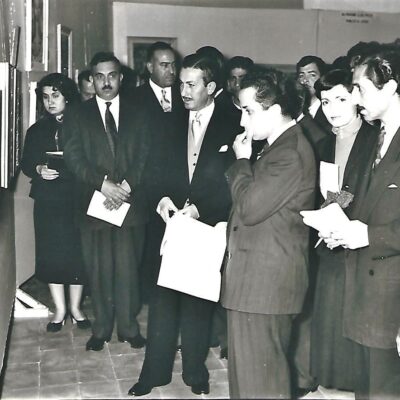
King Faisal II at Iraqi Artist Exhibition, Al Mansour Club, February 1956, from left, visitor, Ziwar Nash'at, Abduljabbar Fahmi, Ali Haider Al Rikabi, the King, Dr. Saniha Amin Zaki, Ali Al Furati. Image Courtesy Elias Jammoo'a (Hussain Al Rikabi Collection).
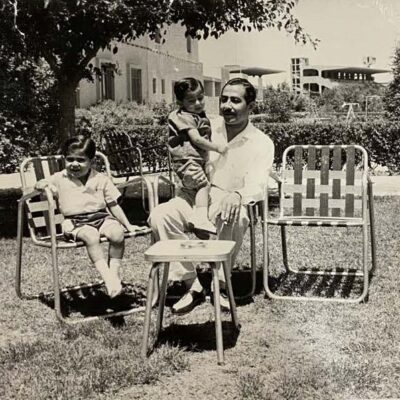
Al Mansour Club children play area: Mr Albert Bashi, Club Manager and sons Munthir and Tariq. Racing Co. Spectators stands appear in background. Image courtesy Tariq Bashi.
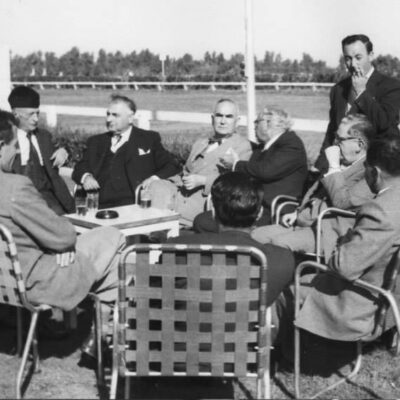
Al Mansour Club garden, right next to the racing-track: Clockwise from left, Dr. Sami Suleyman (with Sidara): Dr. Abdulhadi Al Pachachi, Dr. Ibrahim Akif Al Alousi, TBC, Dr. Fathallah Akrawi, Dr. Salim Al Damluji (standing).
Club members and their families could watch racing horses while sitting comfortably in the garden drinking beer or tea and munching English style little sandwiches. Within the first five years, Club membership rose to seven hundred families. The Iraqi Golf Club rented a small annex from Al-Mansour Club. Their golf course was situated inside the area enclosed by the racing track.
Al-Mansour Club’s annual program included three parties for Children: Christmas, Eid-al-Fitr and Eid-al-Adha. Every year there was a western style dance party and a Baghdadi Chalghi (local folklore). New Year Eve was also celebrated, with European performers brought in from overseas. There were also annual tennis tournaments and swimming contests. The Club hosted other special occasions. Between 1956 and 1958 three exhibitions for the works of Iraqi artists were held in the Club under the sponsorship of King Faisal II. They were quite successful and the artworks were almost sold out every year.
One early wintry morning, probably in 1954, the annual Royal Fox Hunt commenced from the parking lot of Al Mansour Club after soup and sherry were served, British-style, in the lounge to the exclusive group of hunters, including Prince Abdulilah the Regent. With a pack of hounds in the lead, they rode their horses west through the farmland beyond AL MANSOUR City towards Abou Ghreib village. The hunt was bountiful. Many foxes used to live in the area and could be heard howling at night.
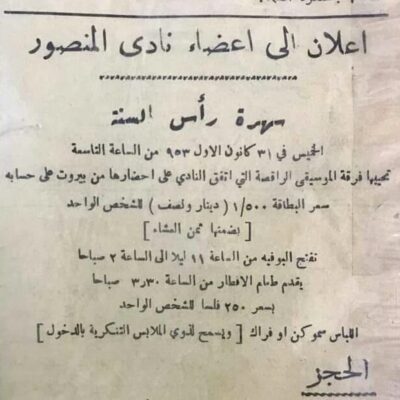
News paper advertisement for New Year Party Al Mansour Club, 1953.
In July 1959 numerous events were held in Iraq to celebrate the first anniversary of the revolution. A temporary stage was set up opposite the Club garden on the inner side of the race track. A Chinese singing/ dancing troupe performed a superb folklore show and sang in Arabic as well, which pleased the audience and General Qassim who was sitting in the front row. A fabulous colourful, fireworks display was performed by the Lebanese manufacturers of the squibs.
The Company also built a six storey residential building containing twenty four apartments with a private car-park at the back. The spacious Al-Yarmook supermarket on the ground floor was popular in the neighbourhood.
The building was designed by the same architect, Katarinchek and the structural design by Niazi Fetto’s office.
Completed around 1960, it was probably the first residential building of that size in Baghdad. It had two lifts and dedicated living quarters for servants. Each apartment contained a large living/dining area, a balcony, western kitchen layout, garbage chutes and other then-novel features.
It was completely occupied by Iraqis during the first two years; until the Qassim government evicted all residents in order to convert the building into accommodations for Soviet experts working for the government. Their minders made sure to seclude them from Iraqis completely. After the Soviet experts moved out a few years later the apartments were leased to Iraqis.
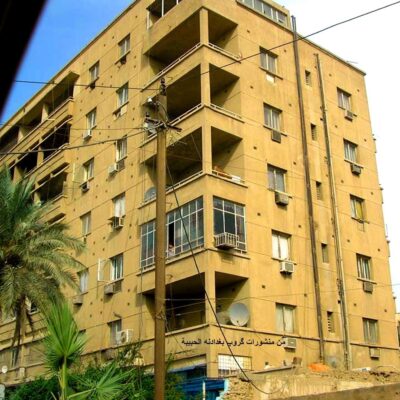
Al Mansour Company residential building.
The 1958 revolutionary government banned Al-Mansour Company from racing activities. The ban lasted eight years before it was lifted after Abdulrahman Aref became President. Later on, following the 1968 revolution, the Baath Party government ‘nationalised’ Al-Mansour Racing Company enterprise, including the site, racing track, buildings and annexes. The Party took complete control, without government supervision. The Company owners were never compensated.
In the 1970s some houses were leased to foreign embassies, government departments, a kindergarten, and commercial offices. The City functionality began to deviate from the master plan. At present I am told that greengrocers, cafés, minimarkets, car repair shops, fast food restaurants, barbershops are everywhere. Many old houses have been demolished; replaced by three or four much smaller houses on the same plots. AL MANSOUR became as over-crowded as most neighbourhoods in Baghdad.
Since I left Iraq in 1973, I visited Baghdad five times only, the last in 1988. Over the years I lost track of the increasing changes, only learning about them from others or watching the rare video I come across. I am told that AL MANSOUR now retains none of its former lustre, with most of the suburb’s original features nearly obliterated. The description I recounted here is based on my memories of AL MANSOUR.
The beautiful Church, inaugurated in the 1960s and welcomed by the local residents, together with the Company’s residential building next door are now probably the only interesting features remaining from the beginnings of AL MANSOUR City.
Cover image:
Al Mansour Co. Grounds aerial view, Clockwise from middle left : spectators stands, Royal Lodge building, pre-race round, offices, annexes, stables, racetrack, betting scores electronic board. Image Curtsey Hunting Aeroservices, London, UK (Hussain Al Rikabi collection)
Notes:
* R. Murdoch, co-owner of Murdoch & Brooks Earthworks Contractors.
** General H.C. Smith, Director of Iraqi Railways until 1950.
Sources:
1) Mohamed Makiya, Notions of the Years (Kawatir Al-Sineen), 2005, 2012
2) Jihan Allawi, Part 1: The works of Ja’far Allawi, a pioneer of Iraqi Architecture, 2012.
Images that are not attributed have been sourced from the internet and are of unknown origin
————————————————————————————————————————————————————————————————————————————————————————————————————
About Hussain Al Rikabi:
Hussain Al Rikabi, a civil engineer born in Baghdad, he graduated from Baghdad University, Iraq; and then worked for two years with Iraq Consult, Baghdad. In Saudi Arabia he worked for thirty years as contract manager of road and building construction projects. He qualified as accredited translator and obtained Australian citizenship in 2006. He was commissioned by Australian and international organizations for translation work on various programs and assignments. Now retired, he resides in Melbourne, Australia.

